ATNF Science Highlights 2002
Millimetre observations of circumstellar disks around the young stars TW Hya and HD 100546The new 3 mm receivers installed at the Compact Array have allowed the observation of the emission from a disk of dust and molecules around two young stars. TW Hya, the closest known T Tauri star, was previously found to be surrounded by a disk extending to at least 200 astronomical units (AU), and is likely to form planets. HD 100546 is surrounded by a halo extending to 8000 AU, which emits infrared radiation similar to that observed in comet Hale-Bopp. The mm observations from TW Hya are in good agreement with the expectations from models derived from observations in other bands, but the emission line of HCO+ (J=1-0) was spatially resolved and indicates that high densities exist even at large radii, as expected for planet formation. Surprisingly, no HCO+ emission was found in HD 100546, and observations of the more abundant CO at 110 GHz to 115 GHz are needed. read more |
 |
Imaging HCN emission around R SclThe evolved star R Sculptoris is surrounded by a shell of gas and dust. Previous single-dish observations had shown that the carbon monoxide (CO) in the shell is detached from the star. The new 3 mm system of the Compact Array allowed the observation of this shell with unprecedented high angular resolution, however, the frequency range allowed the hydrogen cyanide (HCN) line at 88.6 GHz to be observed. The flux was found to be consistent with the single-dish observations, but it turned out that the HCN shell was only barely resolved by the ATCA, and hence closer to the star than the CO. This interpretation is supported by the lower HCN velocities derived from single-dish spectra. Model calculations show that the stellar envelope has a diameter of 1000 astronomical units, when all observational data is taken into account. read more |
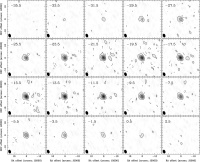 |
Planetary nebulae and butterfly wingsTowards the end of their lives, stars undergo several structural changes in which they lose mass through stellar winds, resulting in a beautiful glow known as planetary nebulae. The shapes of planetary nebulae can be very different, some are circular or elliptical, some are bipolar or exhibit a butterfly-shaped structure. To investigate the cause of this diversity, ATNF astronomers have observed 85 of their immediate precursors, the so-called post-AGB stars. They have observed the radio emission from several molecules to determine the physical conditions in the winds and found a great variety of spectra, some of which could be readily identified with the shapes of the nebulae. Together with other observations, the data will give insight into the origin of the many different shapes of nebulae. read more |
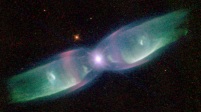 |
The Compact Array captures a "baby" supernovaType II supernova are known not to show any radio emission until months after the collapse. Hence supernova 2000ig, a naked-eye discovery by Australian amateur astronomer Rev. Robert Evans, held a surprise when ATNF astronomers unexpectedly detected its radio emission five days after the explosion. Using a few hours of unallocated time on the Compact Array, the observers had a short look at the supernova at frequencies between 1.4 and 8.6 GHz. Two weeks later, the supernova was also detected with the prototype 12-mm receivers. Compared to light curves from other type II supernovae, the subsequent monitoring of SN2000ig revealed an unusual increase of flux after three months and another unexpected plateau after nine months. The progenitor of SN2000ig probably shed its outer layers before it exploded, but the details of this process still need to be understood. read more |
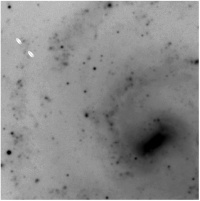 |
Pulsar discoveries at ParkesPulsars, compact remnants of supernova explosions, are not only interesting objects themselves, but also provide information about the physics of the core collapse and are probes of the surrounding medium. Frustratingly, only 10 associations between pulsars and supernova remnants had been established before 2000, despite the 200 supernova remnants and 1400 pulsars known. Even a massive pulsar survey carried out with the Parkes telescope, yielding the discovery of more than 700 pulsars, added only one new pulsar-supernova remnant pair. To improve the situation, a team of ATNF astronomers decided to search for pulsars in pulsar wind nebula. X-ray observations of these nebulae can, sometimes, reveal the presence of a pulsar even if the pulsar is not detected in the radio. In the test case, the supernova remnant G292.0+1.8, the pulses were detected in a 10-hour integration, and even X-ray pulses were found subsequently. This result triggered pulsar searches in pulsar wind nebulae at many major radio telescopes in which six new pulsar-nebula associations were discovered. read more |
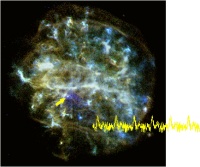 |
Discover of a super-massive spiral galaxyPresent-day galaxies are thought to have formed from merging of smaller galaxies when the universe was between 25% and 50% of its current age. Above a neutral hydrogen (HI) mass of about 6x109 solar masses the number of galaxies rapidly decreases. Using the Parkes multibeam receiver, one of the most massive spiral galaxies known has been discovered. HIZOA J0836-43 has an HI mass of 7x1010 solar masses, which is 20 times more than the Milky Way's mass. Only a handful of galaxies are known to have such large masses. Follow-up observations with the Compact Array showed that the galaxy has a huge diameter of 66 kiloparsecs, and rotates slowly even in its outskirts. This finding implies that HIZOA J0836-43 has a large halo of dark matter. Although the galaxy is located in the plane of the Milky Way, and hence huge amount of dust and gas dim its light, infrared observations with the Anglo-Australian Telescope were successful, and the tilt of the galaxy was measured to be 65°. Despite its mass, HIZOA J0836-43 is otherwise a normal galaxy, which can contribute to theories of galaxy evolution, and demonstrates the benefit of large-scale blind surveys. read more |
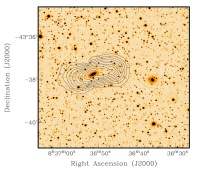 |
First results from the Compact Array 18 GHz pilot surveyIn a pilot project, 1,216 square degrees of the sky were observed using a single baseline of the Compact Array and a new wide-band analogue correlator. Many all-sky radio surveys have been carried out at low frequencies. At higher frequencies, the fields of view of large radio telescopes are too small to carry out similar surveys. However, measuring the high-frequency properties of extragalactic radio sources is crucial for interpreting maps of the cosmic microwave background and is also important for studies of active galaxies and their cosmic evolution. The survey made use of the new 12-mm receivers and of a prototype analogue correlator, yielding a bandwidth of 4 GHz and thus high sensitivity even with short integration times. Within five days, 1,216 square degrees were observed with a sensitivity limit of 60 milliJansky. Accurate position measurements and source identifications were done in follow-up observations. read more |
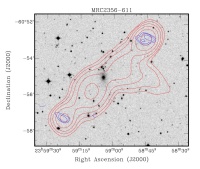 |
An unbiased census of hydrogen in the local universeBetween 1997 and 2002, a new 21-cm receiver at the Parkes telescope was used to survey the entire southern sky in a search for neutral hydrogen (HI). The first task was to separate extragalactic emission from the noise and man-made interference in the data, which was accomplished using a combination of computer programs and subsequent manual inspection of the results. 4300 HI-selected galaxies remained, almost twenty times more than in any comparable sample. One of the strengths of the survey is that it is entirely unaffected by absorption in the Milky Way and thus measures the galaxy distribution equally in all directions. A detailed analysis shows that the HI galaxies cluster less strongly than the galaxies surveyed in optical bands. The finding can probably be attributed to two effects. First, the HI galaxies may only exist in regions with fewer galaxy interactions, which would cause star formation and hence decrease the amount of neutral hydrogen, and second, HI-rich galaxies are actually formed in lower density regions. Another outstanding result of the survey is a precise determination of the Universe's current HI density. read more |
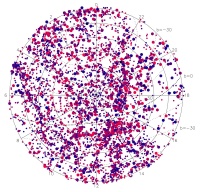 |
The Southern Galactic Plane SurveyRadio astronomers have observed the interstellar medium (ISM) for more than 50 years, but still its properties are poorly understood. The Southern Galactic Plane Survey (SGPS), imaging a huge area of the sky at the frequency of neutral hydrogen (HI), sheds some light on the many questions of ISM dynamics and thermodynamics. Both the Parkes telescope and the Compact Array have observed 335 square degrees of the sky, yielding deep images over a wide range of angular resolution. The survey's full polarisation information contributes to the understanding of the Milky Way's magnetic fields, and collaboration with northern-hemisphere institutions will finally result in an HI atlas of the entire Galactic plane. The first part of the SGPS has already resulted in the discovery of huge HI shells, bubbles, and chimneys, which are driven by stellar winds and supernovae. Furthermore, Galactic HI has now been detected at distances as far as 30 kiloparsecs, which may be a very distant extension of a spiral arm. The spatial distribution of HI velocities is a beautiful confirmation of spiral density wave theory. read more |
 |
